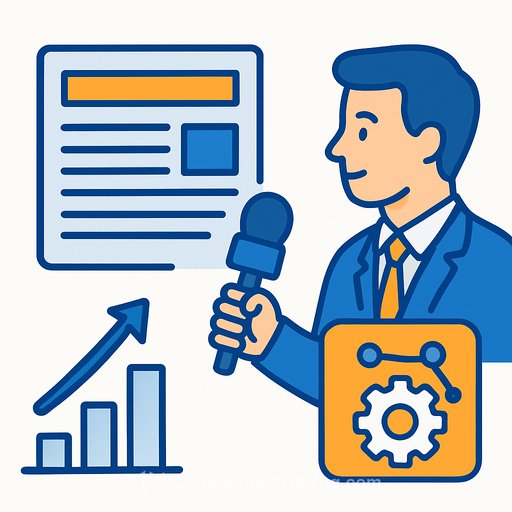How to Make Press Releases Work for Journalists and AI Algorithms
Press releases now serve two masters: people and systems. Yesenia Reinoso, Founder and Principal at Y Communicate, argues that effective releases read like clear stories and act like structured data. That mindset helps journalists move faster and makes your news easier to find across search, social, CMSs and AI aggregators.
The shift: from reporter-first to systems-aware
- Write for humans, format for machines. Treat each release as a narrative plus a machine-readable data package.
- Prioritize scannable facts: names, dates, locations, numbers, links and assets that can be reused without guesswork.
- Add authoritative links that confirm claims. This builds trust with reporters and signals credibility to search systems.
What journalists want right now
- Verifiable specifics: Provide concrete data points, a short methodology note and source URLs.
- Rapid reuse facts: Include pre-approved quotes, correct spellings, pronunciation guides and rights-cleared media.
- Direct expert access: Offer office hours, a booking link or a media hotline for quick interviews.
Practical steps to boost search and AI discovery
- Lead with clarity: Your first sentence should answer who, what, where, when and why.
- Use descriptive H2s: Break sections by topic so both readers and AI can parse your release quickly.
- Publish a brief FAQ: Anticipate reporter questions and make answers easy to extract.
- Permanent URLs: Share stable links to media kits, documents and data sources.
- Accessible assets: Provide B-roll, screenshots, logos, social-ready posts and alt text in common formats.
- Structured data: Mark up your release as an article to aid indexing and context. See Google's guidance on Article structured data.
Write for readers, make it friendly to AI
- Start with the facts, then add a detail that hooks interest.
- Choose concrete nouns and specific numbers over vague claims.
- Include a short Q&A block when relevant for clean information extraction.
- Make link text descriptive so both users and machines know its purpose.
- End with an editor's section: extra context, sources and contacts.
Recommended release structure
- Headline: Clear subject + action.
- Lead sentence: Who, what, where, when, why.
- Body sections (H2): Key announcement details, impact, data, quotes, next steps.
- FAQ (3-5 items): Focus on timing, availability, pricing, access and method.
- Media kit URL: One permanent link with all assets and usage notes.
- Boilerplate: Concise company description with one authoritative link.
- Editor's section: Contacts, office hours, booking link, pronunciations, rights, methodology, source links.
FAQ block example
- Q: Who is available for interviews? A: CEO Jane Doe and VP Research Alex Kim; book at calendly.com/brand/press.
- Q: What data supports this announcement? A: 1,284-customer survey (June-Aug 2025); methodology and raw tables linked in the media kit.
- Q: Where can I find rights-cleared visuals? A: B-roll, product shots and infographics are in the media kit with usage guidelines.
Editor's section checklist
- Primary contact: name, email, mobile, timezone.
- Office hours or booking link for rapid interviews.
- Correct spellings and pronunciation guide for names and products.
- Quotes cleared for reuse, with speaker titles.
- Data methodology summary and links to source materials.
- Rights-cleared media with captions, credits and alt text.
Quality signals that help both reporters and search
- Attribute every stat and hyperlink the original source.
- Keep numbers consistent across the release, media kit and social posts.
- Use plain language; avoid buzzwords and ambiguous claims.
- Host assets on fast, public URLs with clear filenames and captions.
Distribution notes for search, social and AI aggregators
- Publish on your site first with a clean URL, meta title and meta description.
- Post a short thread of key facts and a media kit link on your social channels.
- Offer transcripts for audio/video; include alt text for images and thumbnails.
- Email a concise note to media featuring the 5W lead, two key numbers and one quote.
Next step
Adopt a systems-aware template and make it a team habit. If you want structured practice on AI-first media workflows, explore curated AI course paths for PR and communications roles.
Get Daily AI News
Your membership also unlocks:
700+ AI Courses
700+ Certifications
Personalized AI Learning Plan
6500+ AI Tools (no Ads)
Daily AI News by job industry (no Ads)






